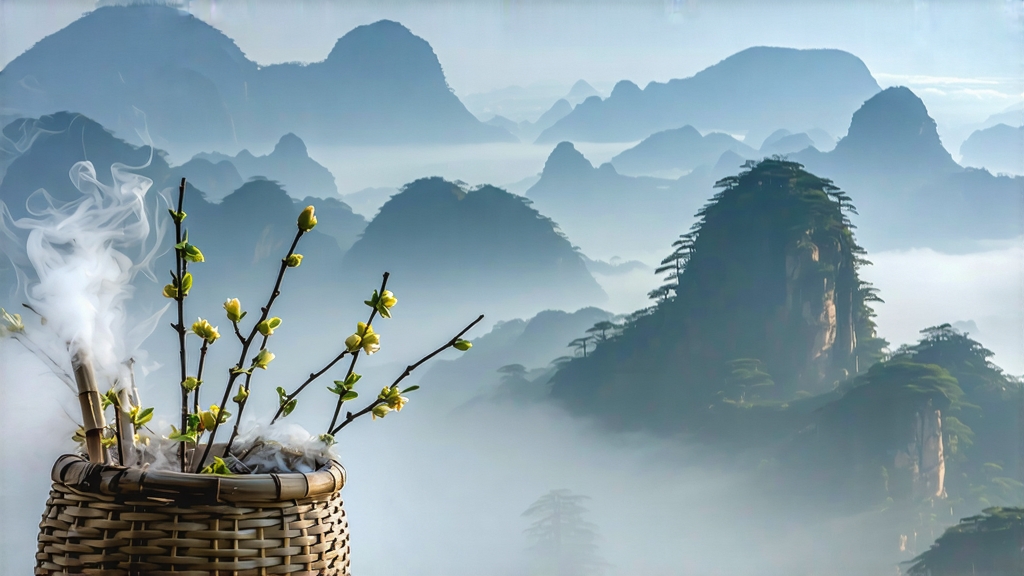
Tucked high on the mist-locked slopes of Meng Ding Mountain in Sichuan Province, Meng Ding Huang Ya—literally “Meng Ding Yellow Bud”—is the quiet aristocrat of Chinese tea. While green teas grab export headlines and pu-erhs court collectors, this yellow tea has spent centuries cloaked in mountain fog and palace secrecy. Today it is emerging as a connoisseur’s darling, yet it still carries the hush of an earlier China, when emperors dispatched horseback couriers for the first spring buds and poets compared their liquor to “the first moonlight on snow.”
Historical whispers
Meng Ding Shan, the “Bright Summit,” has been sacred to tea since the Tang dynasty (618-907 CE). The Daoist monk Wu Lizhen is said to have planted seven tea bushes here in 53 BCE; by the Tang, those bushes were mythic, their offspring reserved for the throne. Song-era records list “Meng Ding Huang Ya” among the six tribute teas of Sichuan, and Ming dynasty statutes fixed the picking day at the first thunder of spring. When the Qing turned to greener tastes, yellow tea techniques faded; only a few families on the mountain kept the slow “sealed yellowing” alive. Rediscovered in the 1950s and again in the 2000s, the tea is now protected as a China-time-honored brand, yet annual production remains below three tons—rarer than many Burgundy grand crus.
Microclimate & cultivar
The garden zone sits between 800 m and 1 400 m, washed by Sichuan’s perennial cloud sea. Average humidity hovers at 85 %, diffusing sunlight into a soft, silver glow that coaxes the tea bushes—predominantly the local Xiaoye zhong (small-leaf) cultivar—to stock amino acids while keeping catechins gentle. Night temperatures can drop 10 °C, forcing the plants to tighten cell structure, concentrating fragrance. Soil is yellow-brown loam rich in quartz and humus, draining quickly so that roots “suffer” just enough to heighten aromatic complexity.
Plucking etiquette
True Meng Ding Huang Ya is picked only for ten days around Qingming festival. Two standards exist: the imperial grade takes the unopened bud alone (≈8 mm), yielding 45 000 buds per 500 g; the superior grade allows one leaf just unfolding, the “sparrow’s tongue.” Pickers work before 09:00, laying the harvest into shallow bamboo baskets lined with banana leaf to prevent bruising. Leaves must reach the village workshop within two hours; any delay starts enzymatic oxidation that would later distort the signature “yellow” character.
Craft: the lost 48 hours
Yellow tea’s soul lies in men huang—“sealed yellowing”—a step that walks the tightrope between green and black tea oxidation. After picking the buds are wilted for 30 minutes on bamboo trays, then wok-fired at 160 °C for three minutes to kill surface enzymes. While still warm they are wrapped in thick cotton cloth and placed in a humid “yellowing room” kept at 28 °C and 75 % RH. Inside the bundle the leaves respire, turning from jade to pale gold over 24–48 hours; technicians open the cloth every six hours to release CO₂ and check aroma. When the bud tips acquire a faint straw-yellow and exude notes of steamed pumpkin, the cloth is removed and the leaves are gently baked over charcoal embers at 60 °C until moisture falls to 5 %. The entire cycle demands at least 70 hand-touch points, explaining why a kilogram of finished tea needs 25 worker-hours.
Leaf appearance & aroma
Dry buds are slim needles, yellow-green with a downy silver tip. A gentle shake in a white cup releases layered perfume: fresh maize, mountain orchid, and a trace of toasted sesame. Because the yellowing step polymerizes some catechins into theaflavins, the tea lacks the grassy bite of spring greens, offering instead a rounded, custard-like sweetness.
Water & ware
Meng Ding Huang Ya prefers soft, neutral water with 50–80 ppm TDS; Highland Spring or filtered Vancouver tap both work. Heat to 85 °C—just when the kettle forms pin-size bubbles (“crab eyes”). Glass tulip gaiwan (120 ml) or tall Duanni clay pot best display the liquor color; avoid porcelain that has been high-fired, as it exaggerates brightness and flattens texture.
Step-by-step brewing
- Warm the vessel with 90 °C water, discard.